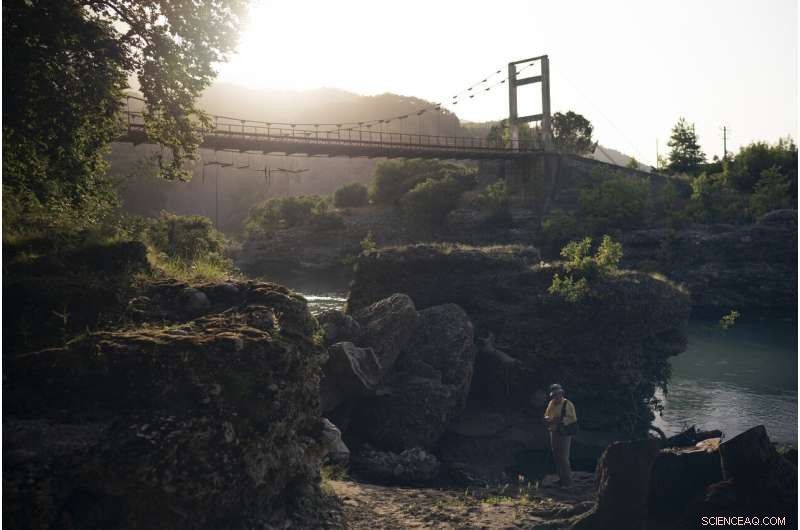
In questo 14 giugno, 2019 foto, Jorgji Ilia, 71, sorge sulla riva del fiume Vjosa dopo aver raccolto l'acqua da una piccola sorgente nel villaggio di Kanikol, Albania. "Non c'è niente di meglio del fiume, " dice la maestra in pensione. "La Vjosa dona bellezza al nostro villaggio." (AP Photo/Felipe Dana)
Sotto un grande platano vicino al confine dell'Albania con la Grecia, Jorgji Ilia riempie una borraccia malconcia da una delle tante sorgenti del fiume Vjosa.
"Non c'è niente di meglio del fiume, " dice la maestra in pensione. "La Vjosa dona bellezza al nostro villaggio."
Il Vjosa è capriccioso e volubile, passando dal blu cobalto traslucido al marrone fango al verde smeraldo, da un flusso costante a un torrente impetuoso. Nulla lo trattiene per più di 270 chilometri (170 miglia) nel suo percorso attraverso i pendii ricoperti di foreste delle montagne del Pindo in Grecia fino alla costa adriatica dell'Albania.
Questo è uno degli ultimi fiumi selvaggi d'Europa. Ma per quanto tempo?
Il governo albanese ha messo in moto piani per arginare il Vjosa e i suoi affluenti per generare l'elettricità tanto necessaria per uno dei paesi più poveri d'Europa, con l'intento di costruire otto dighe lungo il fiume principale.
Fa parte di un boom idroelettrico mondiale, principalmente nel sud-est asiatico, Sud America, Africa e parti meno sviluppate dell'Europa. Solo nei Balcani, circa 2, 800 progetti per domare i fiumi sono in corso o pianificati:uno "tsunami della diga, " dice Olsi Nika di EcoAlbania, un'organizzazione no profit che si oppone ai progetti.
Alcuni dicono che l'energia idroelettrica è affidabile, fonte di energia economica e rinnovabile che aiuta a ridurre la dipendenza dai combustibili fossili che riscaldano il pianeta come il carbone, petrolio e gas naturale. Il gruppo intergovernativo di esperti sui cambiamenti climatici afferma che ha "un potenziale significativo" per ridurre ulteriormente le emissioni di carbonio.
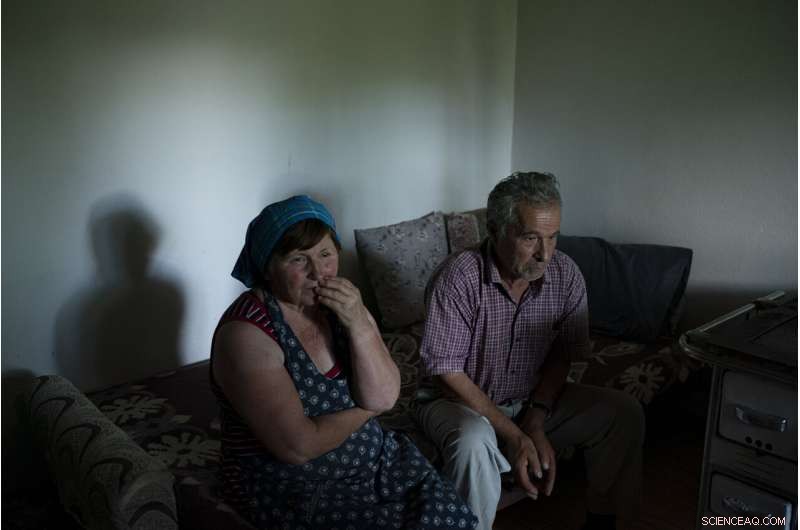
In questo 19 giugno, 2019 foto, Jorgji Ilia, 71, un insegnante in pensione, si siede con sua moglie, Vito, 64, all'interno della loro casa nel villaggio di Kanikol, Albania. "Non c'è niente di meglio del fiume, " dice. "La Vjosa dona bellezza al nostro villaggio." (AP Photo/Felipe Dana)
Ma alcuni studi recenti mettono in dubbio il valore dell'energia idroelettrica nella lotta contro il riscaldamento globale. Critici come EcoAlbania affermano che i benefici dell'energia idroelettrica sono sopravvalutati e superati dai danni che le dighe possono fare.
I fiumi sono una parte cruciale del ciclo idrico globale. Agiscono come arterie della natura, trasportando energia e sostanze nutritive attraverso vasti paesaggi, fornire acqua da bere, produzione e industria alimentare. Sono un mezzo di trasporto per persone e merci, e un paradiso per diportisti e pescatori. I fiumi ospitano una varietà di pesci, inclusi piccoli pesciolini, trote e salmoni e forniscono riparo e cibo a uccelli e mammiferi.
Ma le dighe interrompono il loro flusso, e la vita dentro e intorno a loro. Mentre l'installazione di scale per pesci e l'ampliamento di tunnel per aggirare le dighe aiuta alcune specie, non ha funzionato in posti come l'Amazzonia, dice Julian Olden, un ecologista dell'Università di Washington che ha studiato gli impatti delle dighe in Brasile, Australia e Stati Uniti
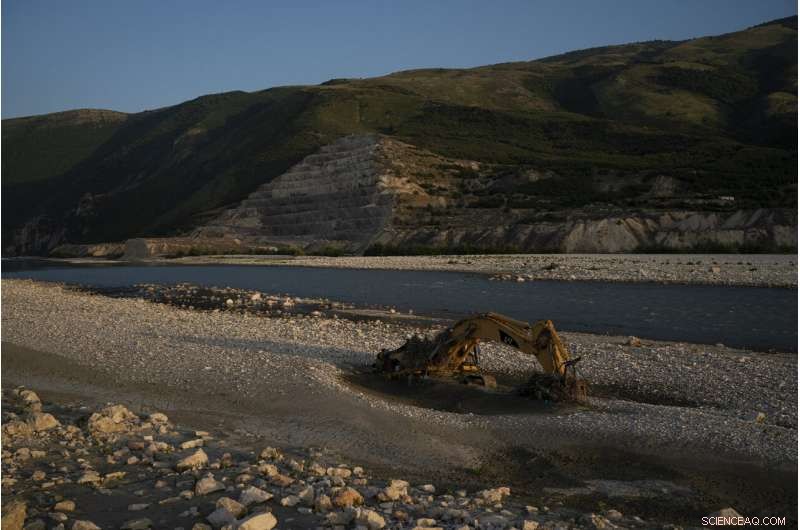
In questo 23 giugno, 2019 foto, un bulldozer abbandonato si trova sulle rive del fiume Vjosa nel cantiere della diga di Kalivac in Albania. Alcuni dicono che l'energia idroelettrica è affidabile, fonte di energia economica e rinnovabile che aiuta a ridurre la dipendenza dai combustibili fossili che riscaldano il pianeta come il carbone, petrolio e gas naturale. Ma alcuni critici come EcoAlbania affermano che i benefici dell'energia idroelettrica sono sopravvalutati e superati dai danni che le dighe possono fare. (Foto AP/Felipe Dana)
Le dighe bloccano il flusso naturale di acqua e sedimenti, e può causare sbalzi di temperatura dannosi. Possono anche cambiare la chimica dell'acqua e causare la crescita di alghe tossiche.
"Una volta che le dighe entrano, non si torna quasi indietro, " Dice Olden. "Fai morire di fame un fiume d'acqua. Non sorprende che i suoi abitanti possano scomparire".
Coloro che vivono lungo la riva del fiume o fanno affidamento sul corso d'acqua per il loro sostentamento temono che le dighe possano uccidere il Vjosa come lo conoscono. Il suo fragile ecosistema sarà irreversibilmente alterato, e molti residenti perderanno la loro terra e le loro case.
"È come gli umani, "dice Elton Pashollari, una guida di rafting i cui clienti sono sempre più attratti dalla natura selvaggia del Vjosa. "Cosa succede se una delle tue arterie, si ferma, il sangue non circola più? È la stessa cosa con il Vjosa".
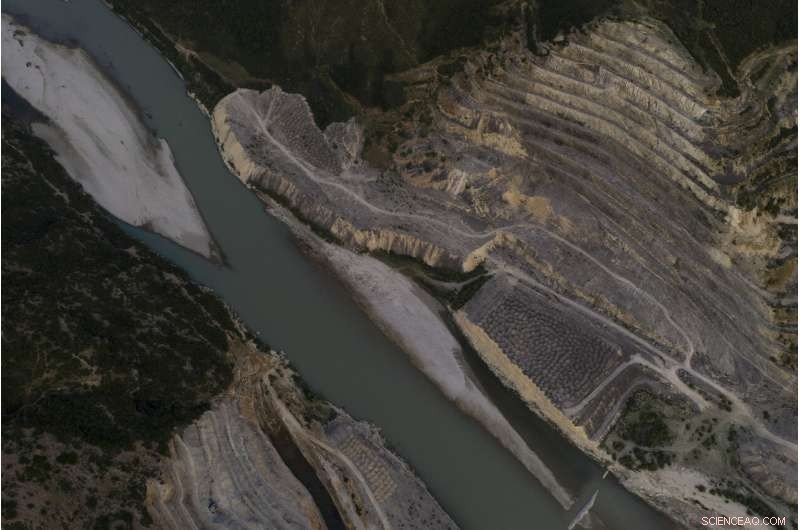
Questo 23 giugno La foto aerea del 2019 mostra il cantiere della diga di Kalivac sulle rive del fiume Vjosa in Albania. Con l'intensificarsi della pressione per la costruzione di dighe nei paesi meno sviluppati, sta accadendo il contrario negli Stati Uniti e nell'Europa occidentale, dove c'è un movimento per abbattere le dighe considerate obsolete e dannose per l'ambiente. (Foto AP/Felipe Dana)
___
Dal platano di Ilia vicino al confine greco, il Vjosa scorre verso nord attraverso strette gole prima di passare dalla città di Tepelene, sempre più languido e allargandosi in ampi banchi di ghiaia, il suo flusso si divide in trefoli, quello che gli scienziati chiamano un fiume intrecciato.
This characteristic is typical of wild rivers and is critical to the local ecosystem. It creates diverse habitats and allows sediment to flow, fertilizing the floodplains and rejuvenating the riverbed.
It is here that the Vjosa reveals another side of its wild nature. After seasonal floods, the river can change course, its braids re-forming along the deep gravel that serves as a filter and self-purification system. It skips from left to right to the center, across an area around 1.5 kilometers (1 mile) wide.
"A natural river is a dynamic river ... a living river, " says Nika of EcoAlbania. "It's living day by day and it changes its face. After each flood, you could never see the same scenery."
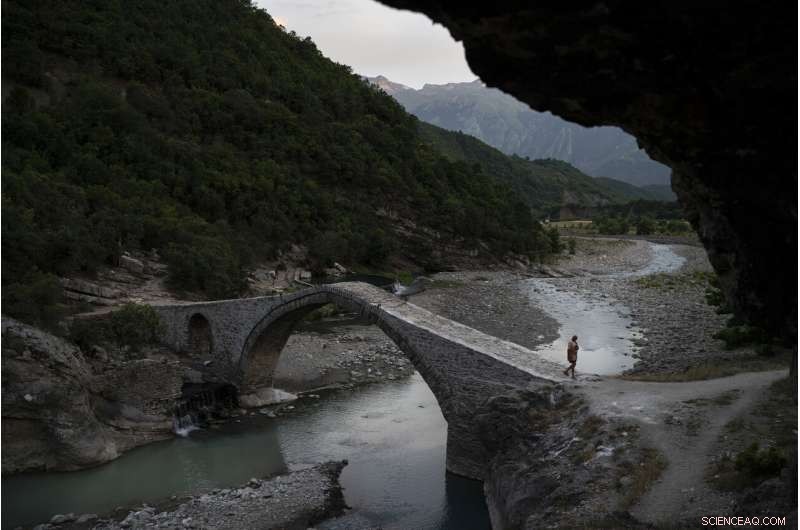
In this June 18, 2019 foto, a man crosses a bridge over the Langarica River, a tributary to the Vjosa near the city of Permet, Albania. Albania's government has set in motion plans to dam the Vjosa and its tributaries to generate much-needed electricity for one of Europe's poorest countries, with the intent to build eight dams along the main river. (AP Photo/Felipe Dana)
The river's ability to clean itself has proved crucial in a country where waste management is often rudimentary. Per anni, people have dumped trash in gullies that washed into the river, leaving trails of plastic and cloth clinging to tree branches. Some towns still dump raw sewage, but the river's self-cleansing means that the overall water quality is passable.
About 25 kilometers (16 miles) northwest of Tepelene, the riverbed narrows into another tight, steep gorge teeming with life, where birds swoop from trees anchored precariously in the cliff-face. Just beyond that comes the first sign of how dramatically a dam would affect the river and the life connected to it.
Emerging from the canyon, it looks like a strip mine. This is Kalivac, one of the proposed dam sites. An Italian company was awarded a contract in the late 1990s. Construction began, but never finished, plagued with delays and financial woes. It now lies derelict with guards stationed to prevent looting.
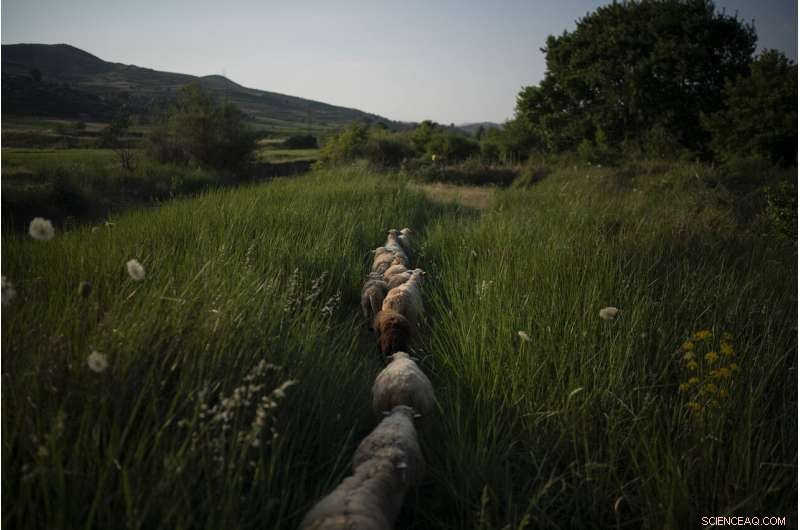
In this June 27, 2019 foto, sheep are pastured near the shore of the Vjosa River in Ane Vjosa, Albania. (AP Photo/Felipe Dana)
Half the hill on one side has been dug away, creating giant steps into the rock. Vehicles sit abandoned, a digging machine sunken into the ground, branches and debris clinging to its frame.
Ora, the government has awarded a new contract for the site to a Turkish company.
For Benedikt Baeumler, a German advertising executive kayaking the length of the river, the sight was a shock.
"I felt like there's all this wonderful nature, and then suddenly to see these stairs, like the Egyptian pyramids, " lui dice.
A few days earlier and several miles upriver, the 43-year-old had been ambivalent about the hydropower projects, noting his own country had also dammed its rivers.
But what he saw at the Kalivac site changed his mind.
"It was really unbelievable what they did to nature, removing entire parts of the mountain, " Egli ha detto, setting up camp on a sandbar back in June. "I hope this dam is never built."

In this June 28, 2019 foto, Shyqyri Seiti, pulls his fishing net from the Vjosa River near Ane Vjose, Albania. The 65-year-old boatman has been transporting locals, goods and livestock across the river for about a quarter century. The construction of the Kalivac dam would spell disaster for him. Many of the fields and some of the houses in his nearby village of Ane Vjose would be lost. (AP Photo/Felipe Dana)
Many locals agree. Dozens of residents from the village of Kute, further downriver, joined nonprofits to file what was Albania's first environmental lawsuit against the construction of a dam in the Pocem gorge, a short distance downriver from Kalivac. They won in 2017, but the government has appealed.
The victory, while significant, was just one battle. A week later, the government issued the Kalivac contract. EcoAlbania plans to fight that project, pure.
Ecologically, there is a lot at stake.
A 2018 study led by University of Vienna's Fritz Schiemer found the Vjosa was incredibly diverse. The team logged more than 90 types of aquatic invertebrates in the places where dams are planned, plus hundreds of fish, amphibian and reptile species, some endangered and others endemic to the Balkans.
But "the majority of the specific biodiversity will disappear in the case of the planned dam constructions, " they warned.
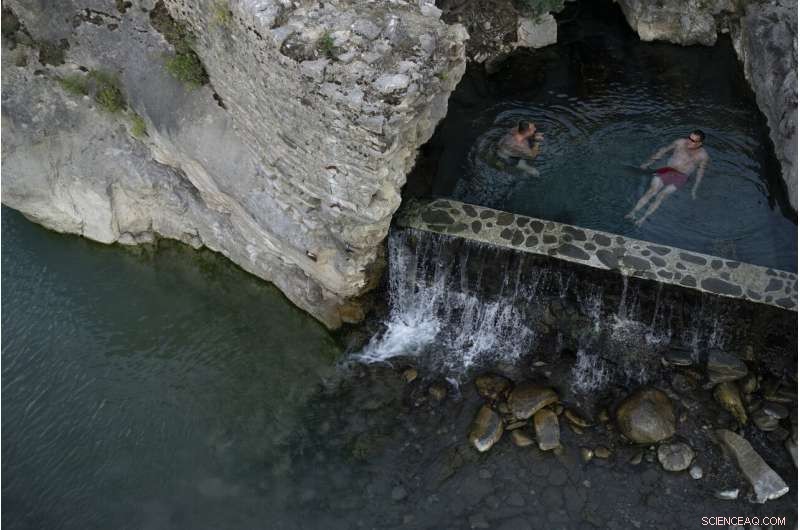
In questo 20 giugno 2019 foto, people bathe in a thermal spring on the banks of the Langarica River, a tributary to the Vjosa near Permet, Albania. (AP Photo/Felipe Dana)
Dams can unravel food chains by reducing populations of insects that feed fish and by limiting spawning, which in turn leaves less prey for fish-eating birds and mammals. But the most well-known problem with building dams is that they block the paths of fish trying to migrate upstream to spawn. The U.S. Atlantic salmon population has plummeted, secondo la National Oceanic and Atmospheric Administration, in great part due to dams.
As pressure to build dams intensifies in less developed countries, the opposite is happening in the U.S. and western Europe, where there's a movement to tear down dams considered obsolete and environmentally destructive.
più di 1, 600 have been dismantled in the U.S., most within the past 30 years, according to the advocacy group American Rivers. In Europa, the largest-ever removal began this year in France, where two dams are being torn down on Normandy's Selune River.
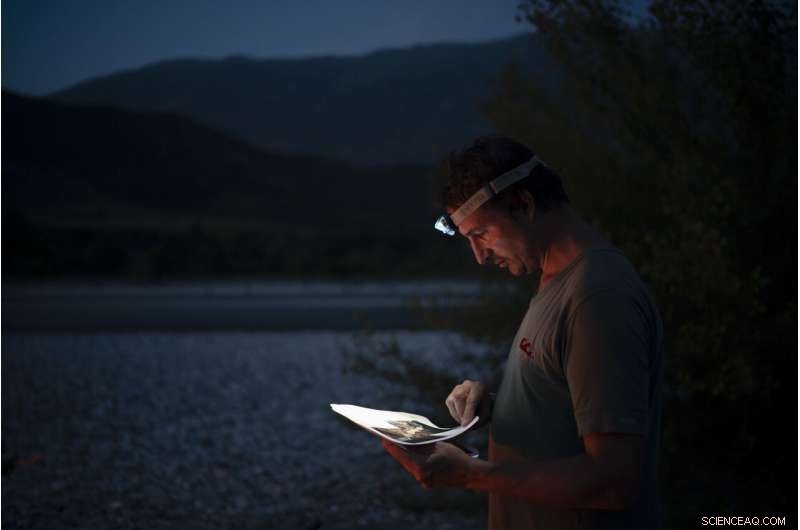
In this June 15, 2019 foto, Benedikt Baeumler, a German advertising executive kayaking the length of the Vjosa River, checks his map after setting up camp on its bank in Albania. A few days earlier and several miles upriver, the 43-year-old had been ambivalent about the hydropower projects, noting his own country had also dammed its rivers. But what he saw at the Kalivac site changed his mind. "It was really unbelievable what they did to nature, removing entire parts of the mountain, " he said. "I hope this dam is never built." (AP Photo/Felipe Dana)
___
With so few wild rivers left around the globe, the Vjosa also is a valuable resource for studying river behavior.
"Science is only at the beginning of understanding how biodiversity in river networks is structured and maintained, " says researcher Gabriel Singer of the Leibniz-Institute in Germany. "The Vjosa is a unique system."
For Shyqyri Seiti, it's much more personal.
The 65-year-old boatman has been transporting locals, goods and livestock across the river for about a quarter century. The construction of the Kalivac dam would spell disaster for him. Many of the fields and some of the houses in his nearby village of Ane Vjose would be lost.
"Per me, the river is everything, " he says. "Someone will benefit from the construction of the dam, but it will flood everyone in the area. ... What if they were in our place, how would they feel to lose everything?"
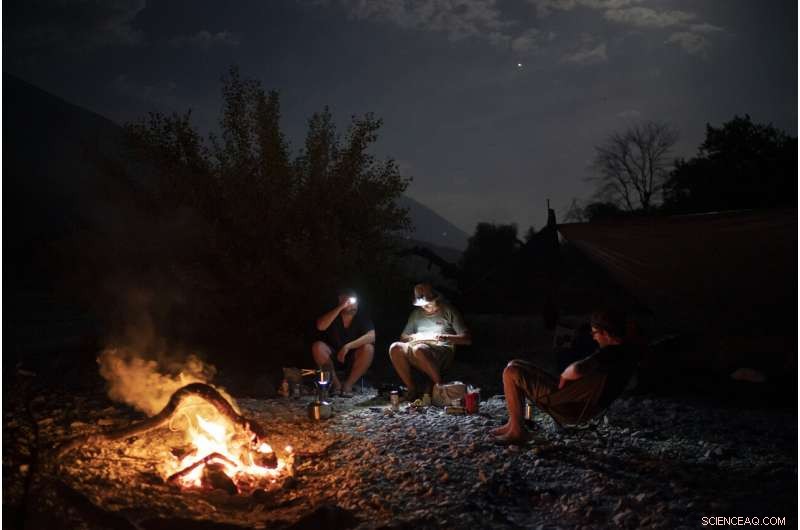
In this June 15, 2019 foto, Jurgen Steinbauer, Benedikt Baumler and Sebastian Baumler, German tourists who are kayaking the length of the Vjosa River, cook a meal as they sit next to a bonfire on the river bank in Albania. After seeing the Kalivac dam construction site, Benedikt Baeumler said, "It was really unbelievable what they did to nature, removing entire parts of the mountain. I hope this dam is never built." (AP Photo/Felipe Dana)
His love for the river runs deep:It feeds his family by providing work and fish to eat and sell. He taught his five children to swim here. Every morning, he runs down to the river just to take in the view.
Seiti has protested against the plans, but some of his neighbors disagree. The mayor, Metat Shehu, insists the community "has no interest" in the matter.
"The Vjosa is polluted. The plants and creatures of Vjosa have vanished, " Shehu says while tending his goats. The biggest issue, he adds, is that villagers are being offered too little to give up their land. He hopes the dam will bring investment to the area.
About 10 kilometers (6 miles) downriver of Ane Vjose lies the village of Kute, on a hill overlooking the Vjosa as it snakes its way north to the sea. Kute residents joined the lawsuit against the Pocem dam that would flood their fields, some houses and, crucially for many, a cemetery. Relieved by their victory, they now wait anxiously for the outcome of the government's appeal.
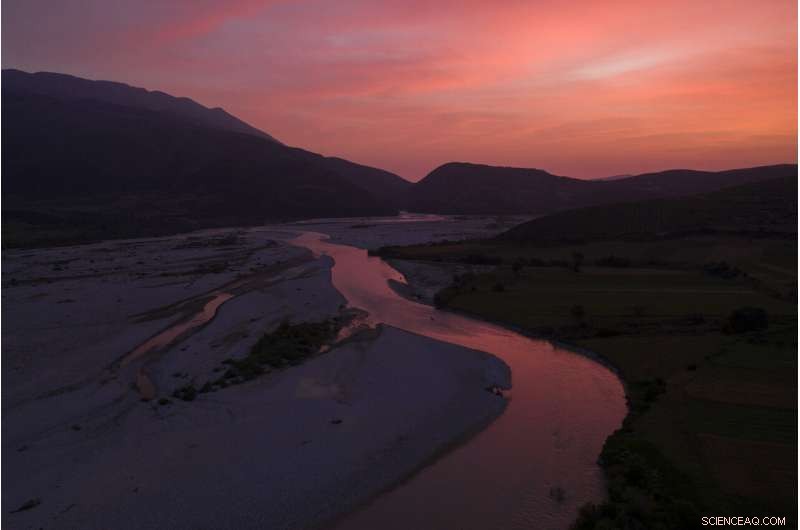
In questa domenica, June 16, 2019 aerial photo, the sun sets behind the Vjosa River near Tepelene, Albania. Rivers are a crucial part of the global water cycle. They act like nature's arteries, carrying energy and nutrients across vast landscapes, providing water for drinking, food production and industry. (AP Photo/Felipe Dana)
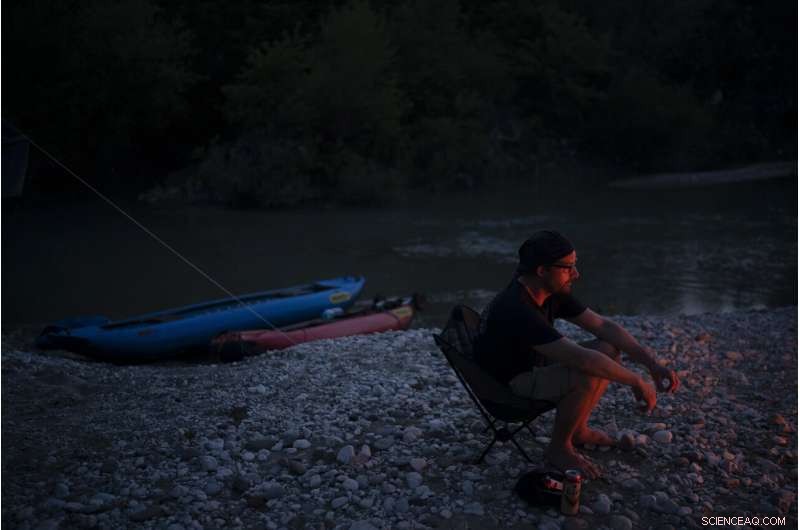
In this June 15, 2019 foto, Sebastian Bäumler, 41, a German filmmaker kayaking the length of the Vjosa River, is illuminated by a bonfire as he sits next to his kayak on its bank in Albania. (AP Photo/Felipe Dana)
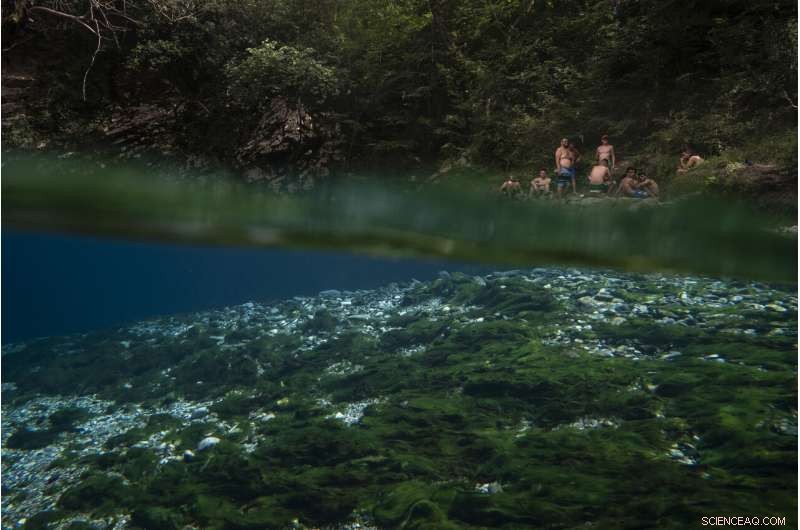
In this June 24, 2019 foto, residents sit on the shore of the Vjosa River next to a spring in the Kelcyre Gorge, Albania. Those who live along the riverbank or rely on the waterway for their livelihood fear dams could kill the Vjosa as they know it. Its fragile ecosystem will be irreversibly altered, and many residents will lose their land and homes. (AP Photo/Felipe Dana)
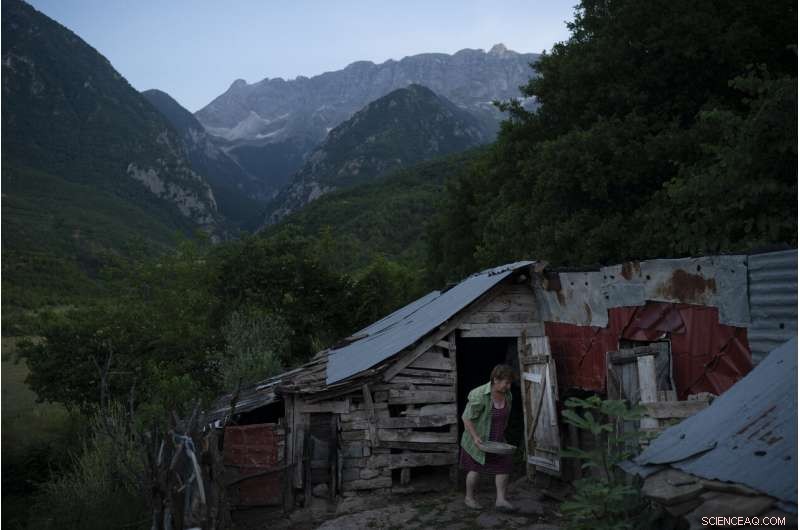
In this June 19, 2019 foto, Vito Ilia, 64, walks out of a small cow shed outside her home in the village of Kanikol, Albania. (AP Photo/Felipe Dana)
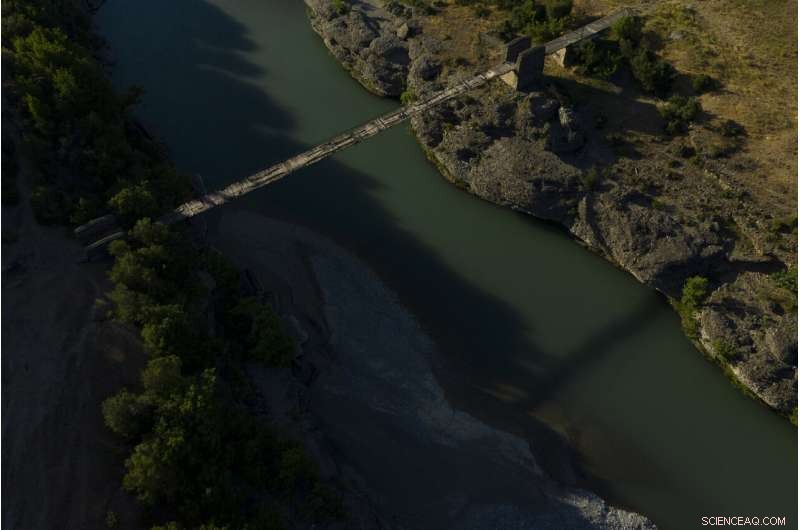
In this June 30, 2019 foto, an old bridge spans the Vjosa River near the border with Greece, in Albania. (AP Photo/Felipe Dana)
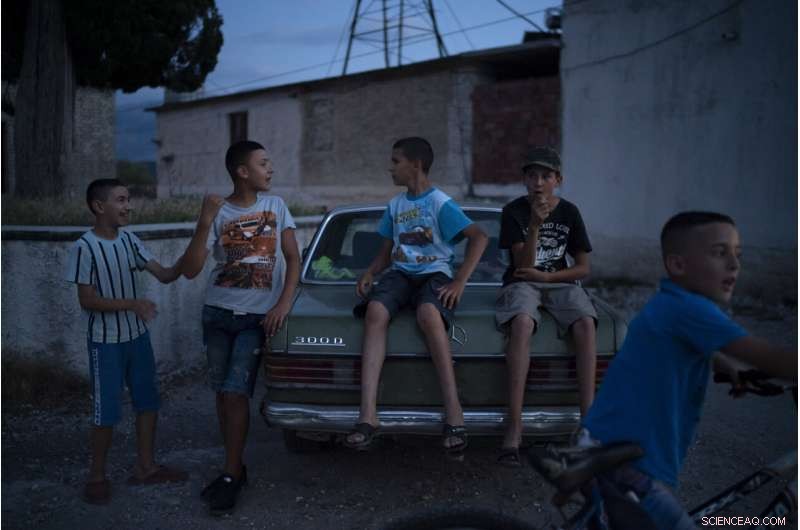
In this June 26, 2019 foto, children play outside at dusk in the village of Kute, Albania. The village overlooks the Vjosa River as it snakes its way north to the sea. Residents here joined a lawsuit against the Pocem dam that would flood their fields, some houses and, crucially for many, a cemetery. (AP Photo/Felipe Dana)
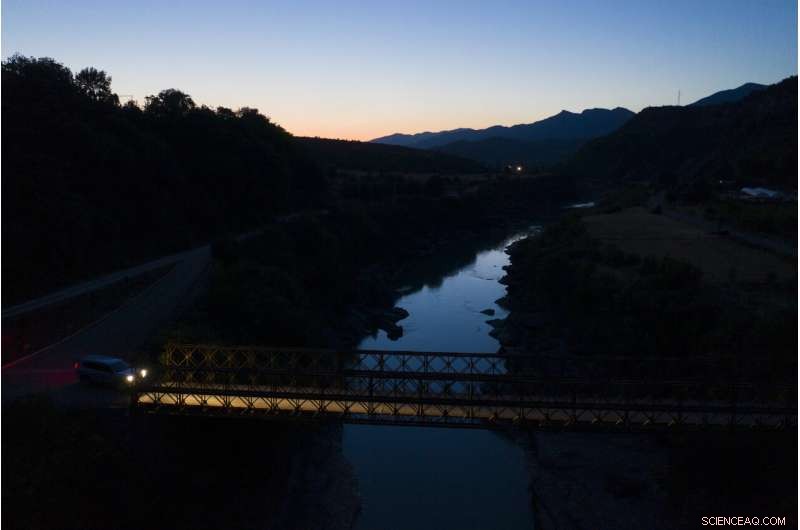
In this June 30, 2019 foto, the sky is reflected in the Vjosa River after sunset near the village of Badelonje, Albania. Rivers are a crucial part of the global water cycle. They act like nature's arteries, carrying energy and nutrients across vast landscapes, providing water for drinking, food production and industry. (AP Photo/Felipe Dana)
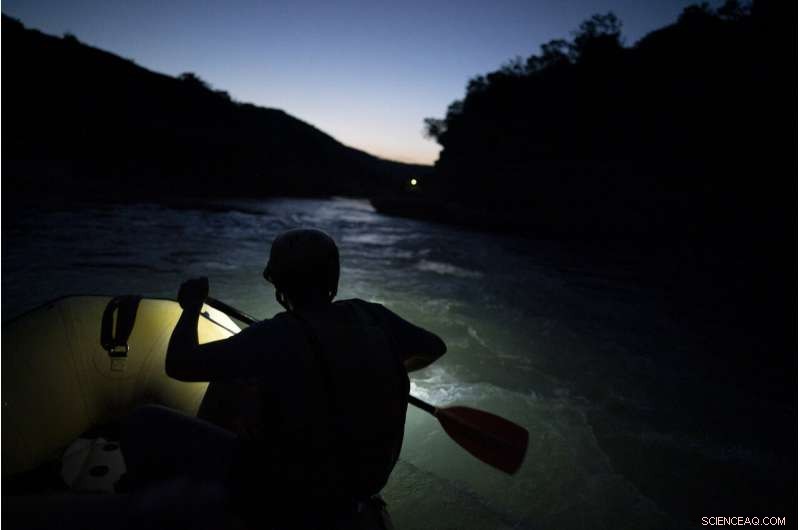
In this June 29, 2019 foto, a river rafting guide paddles at dusk on the Vjosa River, Albania. Those who live along the riverbank or rely on the waterway for their livelihood fear dams could kill the Vjosa as they know it. Its fragile ecosystem will be irreversibly altered, and many residents will lose their land and homes. (AP Photo/Felipe Dana)
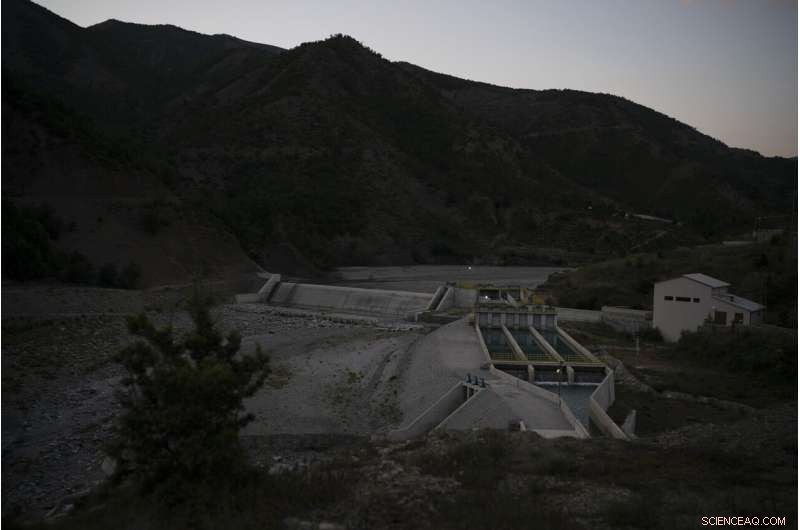
This June 20, 2019 photo shows the Langarica hydropower plant, on a tributary to the Vjosa River near Permet, Albania. As pressure to build dams intensifies in less developed countries, the opposite is happening in the U.S. and western Europe, where there's a movement to tear down dams considered obsolete and environmentally destructive. (AP Photo/Felipe Dana)
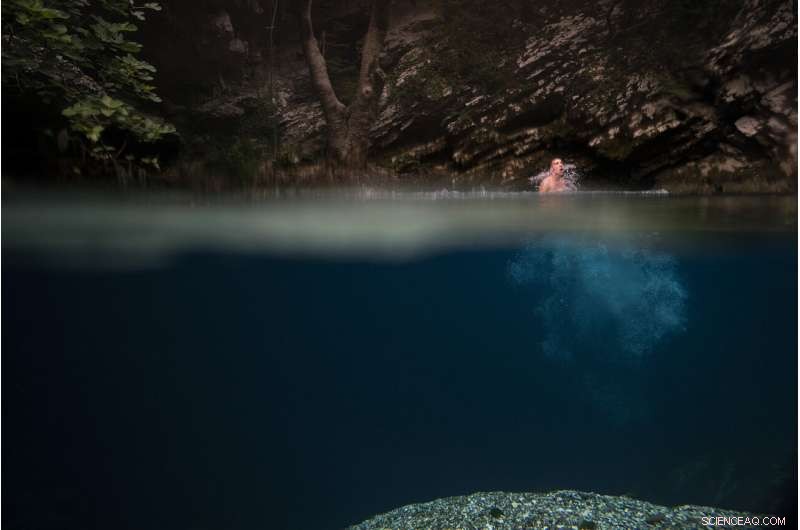
In this June 24, 2019 foto, a man jumps into a spring where it meets the Vjosa River in the Kelcyre Gorge, Albania. Albania's government has set in motion plans to dam the Vjosa and its tributaries to generate much-needed electricity for one of Europe's poorest countries, with the intent to build eight dams along the main river. (AP Photo/Felipe Dana)
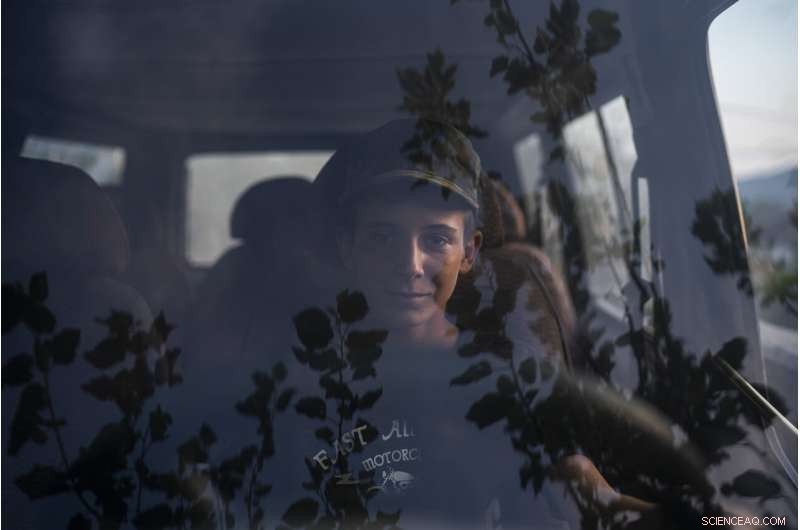
In this June 26, 2019 foto, 13-year-old Eriko, sits in the driver's seat of a car in the village of Kute, Albania. The village overlooks the Vjosa River as it snakes its way north to the sea. Residents here joined a lawsuit against the Pocem dam that would flood their fields, some houses and, crucially for many, a cemetery. (AP Photo/Felipe Dana)
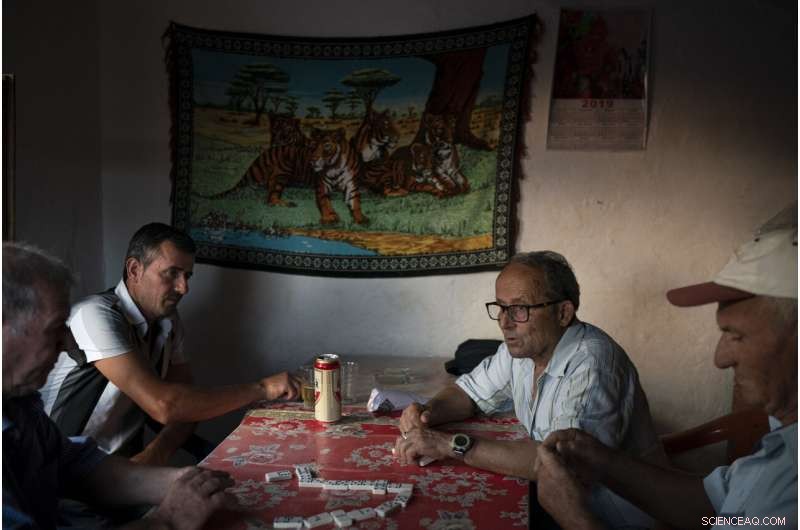
In this June 26, 2019 foto, residents play dominoes in a small bar in the village of Kute, Albania. Dozens of residents from the village joined nonprofit organizations to file what was Albania's first environmental lawsuit against the construction of a dam in the Pocem gorge. They won in 2017, but the government has appealed. (AP Photo/Felipe Dana)
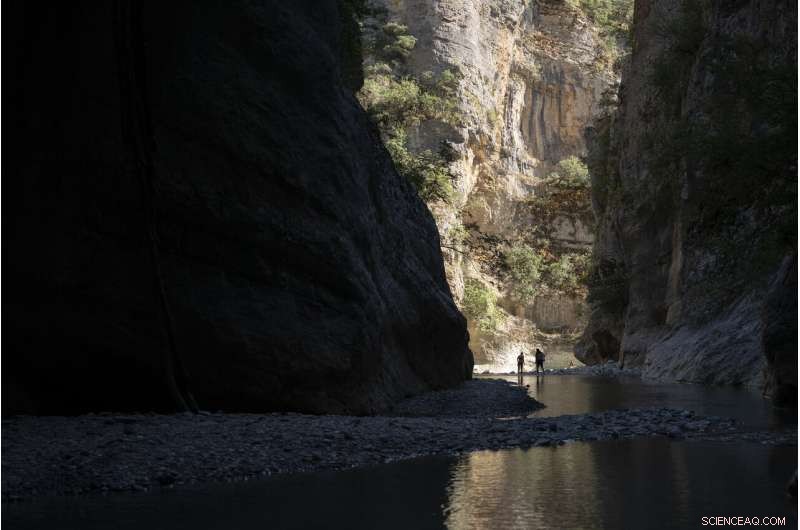
In questo 20 giugno 2019 foto, people walk along the Langarica River, a tributary to the Vjosa near Permet, Albania. Albania's government has set in motion plans to dam the Vjosa and its tributaries to generate much-needed electricity for one of Europe's poorest countries, with the intent to build eight dams along the main river. (AP Photo/Felipe Dana)
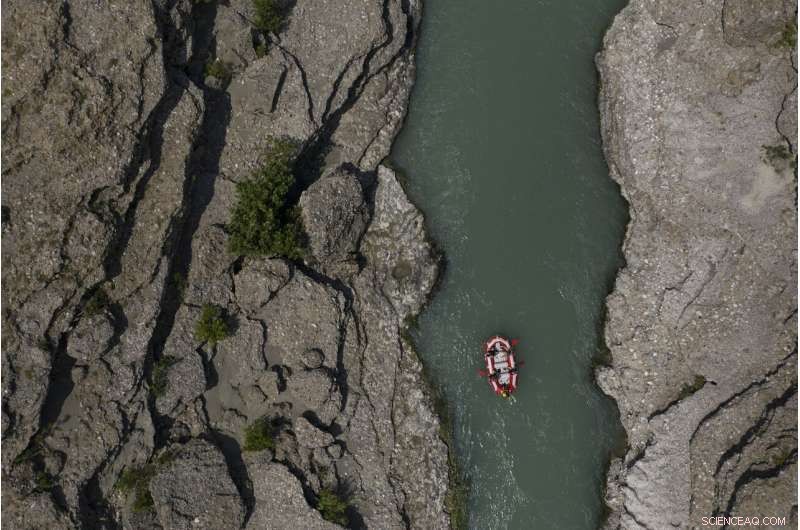
In this June 25, 2019 foto, people raft on the Vjosa River near Permet, Albania. Some tout hydropower as a reliable, cheap and renewable energy source that helps curb dependence on planet-warming fossil fuels like coal, oil and natural gas. But some critics like EcoAlbania say the benefits of hydropower are overstated—and outweighed by the harm dams can do. (AP Photo/Felipe Dana)
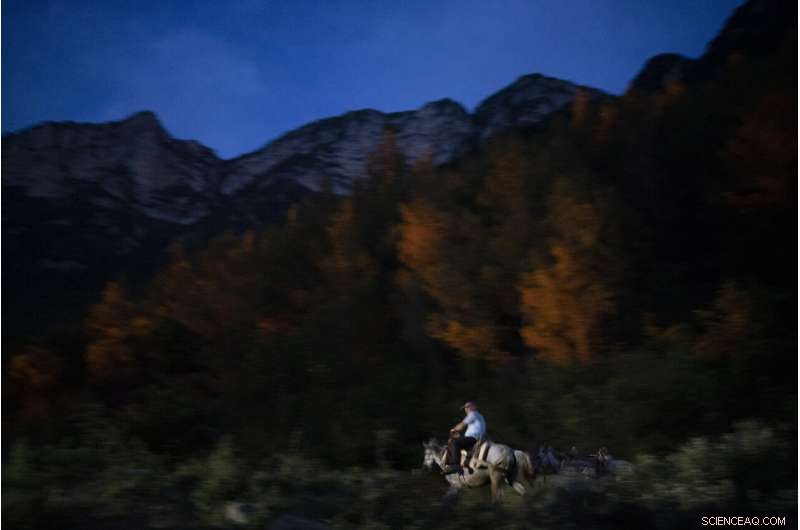
In this June 22, 2019 foto, Jonuz Jonuzi, 70, rides his horse on the banks of the Vjosa River in the Kelcyre Gorge, Albania. He raised his children here and now watches his grandchildren play in the Vjosa's waters. Before dawn each day, he crosses a bridge over a narrow gorge to tend to his goats before his son drives them to drink from a local spring, where the water emerges cold and crystal clear. "Everything I have, I have because of the river, " he says. "Albania needs electrical energy. But not by creating one thing and destroying another. Why do such damage that will be irreparable for life, that future generations will blame us for what we've done?" (AP Photo/Felipe Dana)
There are some signs in their favor. In agosto, the government announced it was canceling a project in central Albania's Holta Canyon near the town of Gramsh, and would tear down part of a dam that's already built. The Infrastructure and Energy Ministry said in a statement the decision came after discussions with residents and an environmental review. Energy ministry officials rejected multiple interview requests to discuss the Vjosa River and the country's hydropower plans.
Could the Vjosa projects also be stopped?
Jonus Jonuzi, a 70-year-old farmer who grew up along the river, still has hope.
He raised his children here and now watches his grandchildren play in its waters. Before dawn each day, he crosses a bridge over a narrow gorge to tend to his goats before his son drives them to drink from a local spring, where the water emerges cold and crystal clear.
"Everything I have, I have because of the river, " he says. "Albania needs electrical energy. But not by creating one thing and destroying another. Why do such damage that will be irreparable for life, that future generations will blame us for what we've done?"
© 2019 The Associated Press. Tutti i diritti riservati.